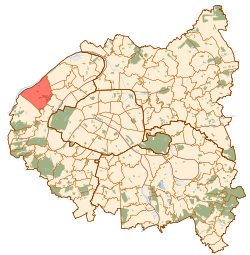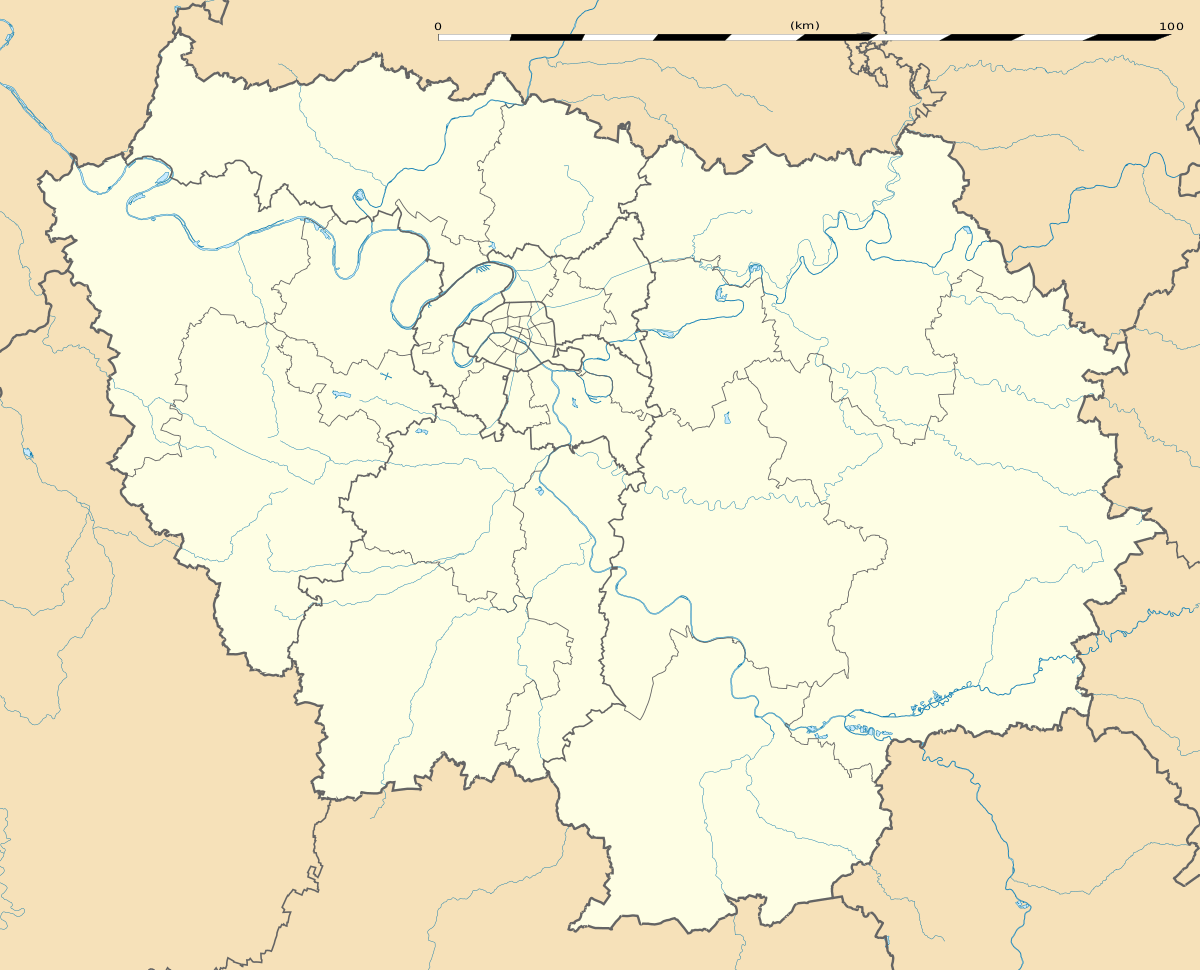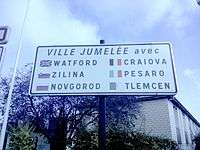Nanterre
Nanterre (/nɒ̃ˈtɛər/, French: [nɑ̃tɛʁ] (![]()
Nanterre | |
|---|---|
Prefecture and commune | |
.jpg) | |
.svg.png) Coat of arms | |
 Paris and inner ring departments | |
Location of Nanterre 
| |
 Nanterre Paris and inner ring departments  Nanterre Nanterre (Île-de-France (region)) | |
| Coordinates: 48°53′56″N 2°11′49″E | |
| Country | France |
| Region | Île-de-France |
| Department | Hauts-de-Seine |
| Arrondissement | Nanterre |
| Canton | Nanterre-1 and 2 |
| Intercommunality | Grand Paris |
| Government | |
| • Mayor (2014–2020) | Patrick Jarry |
| Area 1 | 12.19 km2 (4.71 sq mi) |
| Population (2017-01-01)[1] | 95,105 |
| • Density | 7,800/km2 (20,000/sq mi) |
| Demonym(s) | Nanterriens |
| Time zone | UTC+01:00 (CET) |
| • Summer (DST) | UTC+02:00 (CEST) |
| INSEE/Postal code | 92050 /92000 |
| Elevation | 22–127 m (72–417 ft) (avg. 30 m or 98 ft) |
| 1 French Land Register data, which excludes lakes, ponds, glaciers > 1 km2 (0.386 sq mi or 247 acres) and river estuaries. | |
Nanterre serves as both the capital of the Hauts-de-Seine department and seat of the eponymous arrondissement.
The eastern part of Nanterre, bordering the communes of Courbevoie and Puteaux, contains a small part of the La Défense business district of Paris and some of the tallest buildings in the Paris region. Because the headquarters of many major corporations are located in La Défense, the court of Nanterre is well known in the media for the number of high-profile lawsuits and trials that take place in it. The city of Nanterre also includes the Paris West University Nanterre La Défense, one of the largest universities in the Paris region.
Name
The name of Nanterre originated before the Roman conquest of Gaul. The Romans recorded the name as Nemetodorum. It is composed of the Celtic word nemeto meaning "shrine" or "sacred place" and the Celtic word duron (neuter) "hard, tough, enduring". The sacred place referred to is believed to have been a famous shrine that existed in ancient times.
Inhabitants of Nanterre are called “Nanterrien(ne)s” or "Nanterrois(es)".
History
The sacred shrine of antiquity that is referred to etymologically had been placed by tradition in Mont-Valérien. However, archeological discoveries made between 1994 and 2005 found a Gallic necropolis which has been dated to the third century BC, and also call into debate both the exact location of the pre-Roman capital of the Parisii and the initial site of Lutetia, the Roman era Paris.[2] The large necropolis, as well as working people's homes from some time later in the ancient era, is near the bank of the Seine, in the northwest of Nanterre, and might be the sacred place that is being referred to etymologically. Lutetia is mentioned by Julius Caesar in 50 BCE, reporting an assembly in Lutetia in 53 BC between himself, commander of the Roman Legions, and local Gallic leaders.[3] Although this had been thought to possibly be Île de la Cité, largely since Caesar mentions an island, the river at Nanterre follows two channels around an island. In 52 BC, the Parisii took up arms with the Gallic war leader Vercingetorix, and were defeated by Titus Labienus, one of Caesar's legates. Caesar mentions in his Commentarii that the Parisii destroyed the bridges and set fire to Lutetia before the arrival of the Roman forces. The archeological work in Nanterre has suggested over 15 hectares of pre-Roman or Roman era construction. These archeologic findings may be an indication that Nanterre was the closest pre-Roman settlement to the City's modern centre.[4][3]
Sainte Genevieve, patron saint of Paris, was born in Nanterre ca. 419–422.[5]
On 27 March 2002, Richard Durn, a disgruntled local activist, shot and killed eight town councilors and 14 others were wounded in what the French press dubbed the Nanterre massacre. On 28 March, the murderer killed himself by jumping from the 4th floor of the Quai des orfèvres, in Paris, while he was questioned by two policemen about the reason for his killing in the Nanterre City Hall.
Transport
Nanterre is served by three stations on RER line A: Nanterre – Préfecture, Nanterre – Université, and Nanterre – Ville.
Nanterre – Université station is also an interchange station on the Transilien Paris – Saint-Lazare suburban rail line.
Economy
Société Générale has its headquarters in the Tours Société Générale in La Défense and Nanterre. The company moved into the building in 1995.[6]
Faurecia, the sixth-largest automotive parts supplier, has its headquarters in Nanterre.
Groupe du Louvre and subsidiary Louvre Hôtels have their head office in Village 5 in La Défense and Nanterre.[7][8][9]
Education
Senior high schools include:
Sports
The basketball club Nanterre 92 plays at Palais des Sports Maurice Thorez.
The rugby union club Racing 92 opened the new Paris La Défense Arena in October 2017 and played their first game in the new facility in December 2017.[13] It has a capacity of 32,000 for rugby and 40,000 for concerts. The venue opened as U Arena, but received its current name in June 2018[14] through a sponsorship deal with Paris La Défense, the company that manages the La Défense business district.[15]
Demographics
Immigration
| Born in Metropolitan France | Born outside Metropolitan France | |||
|---|---|---|---|---|
| 75.7% | 24.3% | |||
| Born in Overseas France |
Born in foreign countries with French citizenship at birth1 | EU-15 immigrants2 | Non-EU-15 immigrants | |
| 2.7% | 2.8% | 3.9% | 14.9% | |
| 1 This group is made up largely of former French settlers, such as pieds-noirs in Northwest Africa, followed by former colonial citizens who had French citizenship at birth (such as was often the case for the native elite in French colonies), and to a lesser extent foreign-born children of French expatriates. Note that a foreign country is understood as a country not part of France in 1999, so a person born for example in 1950 in Algeria, when Algeria was an integral part of France, is nonetheless listed as a person born in a foreign country in French statistics. 2 An immigrant is a person born in a foreign country not having French citizenship at birth. Note that an immigrant may have acquired French citizenship since moving to France, but is still considered an immigrant in French statistics. On the other hand, persons born in France with foreign citizenship (the children of immigrants) are not listed as immigrants. | ||||
International relations

Twin towns – sister cities
Nanterre is twinned with:[16]
See also
- La Défense business district.
- List of tallest structures in Paris
- Communes of the Hauts-de-Seine department
References
- "Populations légales 2017". INSEE. Retrieved 6 January 2020.
- Nanterre et les Parisii
- Ancient and Medieval Paris: A Background to the Gothic era. Athena Review Vol.4 No.2 pages 22-26 Archived 9 October 2015 at the Wayback Machine
- Histoire et Histoires: Du 5ème Volume 1 Editions Depeyrot Paris 2014
- Catholic Encyclopedia St. Genevieve
- "Société Générale: deux tours à la Défense". Lejournaldunet.com. Archived from the original on 25 May 2015. Retrieved 7 July 2010. ()
- "Contact Archived 11 September 2010 at the Wayback Machine." Groupe du Louvre. Retrieved on 27 June 2010.
- "Plan interactif Archived 30 August 2009 at the Wayback Machine." Nanterre. Retrieved on 27 June 2010.
- "Legal notice Archived 13 August 2010 at the Wayback Machine." Louvre Hôtels. Retrieved on 27 June 2010.
- "Accueil" (Archive). Lycée Joliot-Curie de Nanterre. Retrieved on June 21, 2015.
- "Accueil Archived 1 August 2015 at the Wayback Machine." Lycée professionnel Paul-Langevin. Retrieved on June 22, 2015.
- "Accueil Archived 5 March 2015 at the Wayback Machine." Lycée professionnel Claude-Chappe. Retrieved on June 21, 2015.
- Escot, Richard (16 October 2017). "Le nouvel écrin du Racing 92, la U Arena, ouvre ses portes". L'Équipe (in French). Retrieved 17 October 2017.
- "La U Arena devient Paris La Défense Arena" [The U Arena becomes Paris La Défense Arena] (Press release) (in French). Paris La Défense Arena. 12 June 2018. Retrieved 18 June 2018.
- Opoczynski, David; Moulin, Louis (7 May 2018). ""Paris La Défense Arena" : la U Arena de Nanterre se fait un nouveau nom" ["Paris La Défense Arena": U Arena in Nanterre receiving a new name]. Le Parisien (in French). Retrieved 19 June 2018.
- "Les six villes jumelées". nanterre.fr (in French). Nanterre. Retrieved 16 November 2019.
External links
| Wikimedia Commons has media related to Nanterre. |
- Official website
- Université Paris 10 Nanterre (in French)
- Nanterre students (in French)
- News coverage of March 2006 University occupation (in English)
- Pictures of Nanterre (in French)
- Nanterre Cathedral gallery of pictures